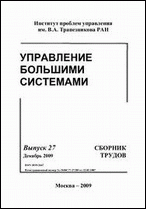|
|
Upravlenie Bol'shimi Sistemami, 2010, Issue 31.1, , Pages 331–358
(Mi ubs483)
|
 |
|
|
Control in Technology and Process Control
Two-level competitive structures in common resource development
Yu. M. Korolev, P. V. Golubtsov
Moscow State University
Abstract:
This paper studies the effects of owner-developer interaction in resource development. Resource is supposed to be allocated among several proprietors, and several companies are permitted to develop it. Marine fishery gives one of the most interesting examples. We study this game in the context of multinational management of transboundary marine fishery. It is well known that unconstrained harvesting often leads to resource depletion. This effect is often called “the tragedy of commons”. The situation becomes more complex when we take into account competition among resource proprietors. Such interaction can be described as a game with players of two different types: proprietors and developers, called first- and second-level players, respectively. The first-level players establish the rules (taxes on development efforts) for the second-level players, who, in their turn, optimize their strategies reasoning from these rules. Every developer receives profit from resource selling and returns part of it to the owner as a tax. The systems described here appear in management problems for energy resources, mineral resources, biological resources, water resources, etc.
Keywords:
optimal resource management, common natural resources, tragedy of commons, two level games, Nash equilibrium, Stackelberg game with multiple leaders, mathematical modeling.
Citation:
Yu. M. Korolev, P. V. Golubtsov, “Two-level competitive structures in common resource development”, UBS, 31.1 (2010), 331–358
Linking options:
https://www.mathnet.ru/eng/ubs483 https://www.mathnet.ru/eng/ubs/v31/i1/p331
|

| Statistics & downloads: |
| Abstract page: | 150 | | Full-text PDF : | 64 | | References: | 45 |
|




 Contact us:
Contact us: Terms of Use
Terms of Use
 Registration to the website
Registration to the website Logotypes
Logotypes







 Citation in format
Citation in format 